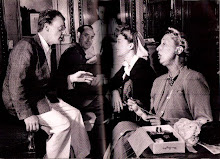 I just recently watched the 1940 James Cagney movie The Fighting 69th, but not for the first time, and it was full of action! James Cagney was superb as Jerry Plunkett, the obnoxious, despicable braggart who soon turns into a coward as soon as he gets down in the trenches! It was very rewarding to see James Cagney in a movie with his two best friends, Pat O'Brien and Frank McHugh, again!
I just recently watched the 1940 James Cagney movie The Fighting 69th, but not for the first time, and it was full of action! James Cagney was superb as Jerry Plunkett, the obnoxious, despicable braggart who soon turns into a coward as soon as he gets down in the trenches! It was very rewarding to see James Cagney in a movie with his two best friends, Pat O'Brien and Frank McHugh, again! Warner Brothers' inspirational tale The Fighting 69th (1940) was an enormous hit with the public when it first premiered in pre-Pearl Harbor America. The studio rightfully assumed that American audiences, well aware of the escalating signs of war in Europe and the Pacific, would respond well to a patriotic action-adventure. And the box office take alone convinced Warner Bros. mogul Jack Warner to continue making gung-ho war films, culminating in a movie about the much-decorated World War I hero, Sergeant York (1941). Like the latter film, The Fighting 69th is based on the true-life story of a World War I hero - Father Duffy, who was played by Pat O'Brien. The real Father Duffy was the regimental chaplain of "the fighting 69th," a group of Irish national guardsmen who were incorporated into the Rainbow Division in 1917 after distinguishing themselves in combat.
Warner Brothers' inspirational tale The Fighting 69th (1940) was an enormous hit with the public when it first premiered in pre-Pearl Harbor America. The studio rightfully assumed that American audiences, well aware of the escalating signs of war in Europe and the Pacific, would respond well to a patriotic action-adventure. And the box office take alone convinced Warner Bros. mogul Jack Warner to continue making gung-ho war films, culminating in a movie about the much-decorated World War I hero, Sergeant York (1941). Like the latter film, The Fighting 69th is based on the true-life story of a World War I hero - Father Duffy, who was played by Pat O'Brien. The real Father Duffy was the regimental chaplain of "the fighting 69th," a group of Irish national guardsmen who were incorporated into the Rainbow Division in 1917 after distinguishing themselves in combat.
Typical of Warner Brothers (and Hollywood), their film version of The Fighting 69th was highly fictionalized. Tom Wicker wrote in Past Imperfect: History According to the Movies that the movie was "stereotypically "Hollywood." (Eh, what are you gonna do?) He also commented that "predictably, the wise guy turns coward in battle; predictably, the wise priest tries to save his soul; predictably, the coward finds God and courage in the end. And when all else fails, as it usually does, the film throws in Frank McHugh for wisecracks and funny faces."


O'Brien's co-star in the picture was James Cagney, who often played the scoundrel in need of redemption from O'Brien's saints in Warner Bros. movies. Together the two actors co-starred in nine films together, including Ragtime (1981), the last film either one of them ever made. Close friends off camera, O'Brien later remarked of his frequent and easily more famous co-star, "Jimmy can steal a scene by lifting an eyebrow." Father Duffy was one of O'Brien's most famous portrayals, while Cagney's was patriotic showman George M. Cohan, whom he played in Yankee Doodle Dandy (1942). Ironically, statues of both of these famous men are still standing in the middle of New York City's Times Square.

Jimmy’s character in this film was very different from his usual characters. He usually made them lovable and cute (in my eyes) but he makes this character disagreeable (well, maybe not so much in my eyes). A scene in this film that I really loved for its use of juxtaposition is a scene where Jimmy Cagney is sitting by a sign that says "NO SMOKING!" But rather predictably, he is disobeying the sign by smoking!
Most of The Fighting 69th was filmed at Warner Brothers' Calabasas Ranch which doubled as Camp Mills, the regiment's training base, various French villages and numerous battlefields. No expense was spared in the pre-promotion of the film, which included a well-publicized meeting in New York City between O'Brien, Cagney, the real Father Duffy and surviving members of the regiment. For this event, more than five thousand fans showed up to greet the two stars when they arrived from Hollywood at Grand Central Station. The real Father Duffy also attended the New York City premiere and shook hands with nearly every actor who appeared in the film, all of whom were of Irish descent. 

The Fighting 69th beat another rival studio's production of the same story to the theatres; Fox had planned to borrow Spencer Tracy from MGM for the starring role in Father Duffy of the Fighting 69th but dropped it once the O'Brien-Cagney picture went into production. When The Fighting 69th was released, the critics were mixed in their reviews. Some derided the movie's clichés while others enjoyed its vitality and pace. Frank Nugent, the film critic at the New York Times (and later a close collaborator of director John Ford), wrote that the film "is better if you can manage to forget the plot, with all it obvious theatrics, hokum and unoriginality, and think of it instead as the human, amusing and frequently gripping record of a regiments' marching off to war." The public, though, loved every minute of it and helped make it one of the biggest moneymakers of the year. (And the public is obviously more important than the critics.)
 James Cagney, Pat O'Brien, and George Brent (who I obviously underestimated by thinking he wasn't a very famous actor but he apparently is) are all billed above the title (that's because they're all better and more important than the f****** title [sorry, but I just had to say that]), and the impressive group of actors is featured in of Warners' most stunning visual "cast parades" before the action begins. William Keighley's depiction of the "Rainbow Division" opens at Camp Mills, New York, featuring fictionalized versions of real-life soldiers Father Duffy, "Wild Bill" Donovan (Brent), and Joyce Kilmer (Jeffrey Lynn), the poet best known for "Trees."
James Cagney, Pat O'Brien, and George Brent (who I obviously underestimated by thinking he wasn't a very famous actor but he apparently is) are all billed above the title (that's because they're all better and more important than the f****** title [sorry, but I just had to say that]), and the impressive group of actors is featured in of Warners' most stunning visual "cast parades" before the action begins. William Keighley's depiction of the "Rainbow Division" opens at Camp Mills, New York, featuring fictionalized versions of real-life soldiers Father Duffy, "Wild Bill" Donovan (Brent), and Joyce Kilmer (Jeffrey Lynn), the poet best known for "Trees." 

And since it's almost Christmas, I thought it'd be appropriate if I added that in one scene, during what seems to be Christmastime, the soldiers, except for Cagney, are in a church singing Christmas carols, and they sing "O Come All Ye Faithful" in Latin. Now I've studied some Latin but I've forgotten most of it, unfortunately. So I could only translate some of the lyrics they were singing. I didn't really watch the battle scenes because I thought they were too dramatic, especially the scene where Cagney gets wounded in a German bomb blast and later dies. I would recommend this film for any James Cagney fan who loves watching him in dramatic war films. Happy commenting!!
 (Next blog: The Bride C
(Next blog: The Bride C ame C.O.D [1941])
ame C.O.D [1941])
 (Next blog: The Bride C
(Next blog: The Bride C ame C.O.D [1941])
ame C.O.D [1941])
Clips from The Fighting 69th:












No comments:
Post a Comment